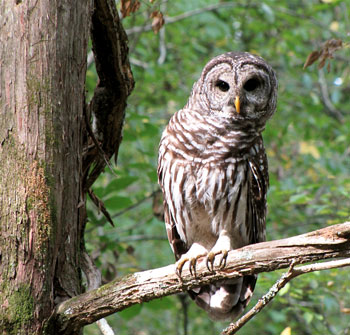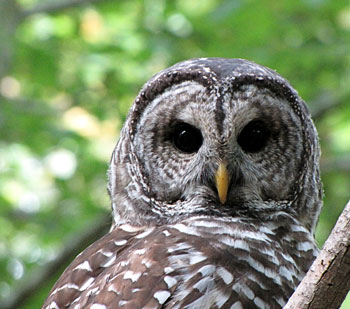by Mary Parker Sonis
Every year in September, we hear the same stories coming out of the Bolin Creek forest. Our beloved ever-present barred owls begin a series of assaults on runners and hikers. Women running at 5:30 a.m. describe attacks on their ponytails and older men show the talon scratches on their bare pates. Nature run amuck.

So why do our owls develop such an antipathy for hikers and runners in the month of September? I have heard many explanations, but they seem to fall short of explaining this aberrant behavior. Some people claim that a ponytail resembles a squirrel tail and the owls are confused. That seems a little far-fetched for an animal with such extraordinary vision. Bald men claim that a bald head will draw an attack, and white hats have been targeted as well.
I did a bit of research on this subject and found out that barred owls are attacking people in September all over the U.S. and Canada. What has come over the owls? The ponytail/squirrel theory is quite popular, and some researchers have claimed that any owl is belligerent near an active nest. True enough, but no barred owls nest in September and the young owls are now dispersing to claim their own territories.
Last year, I was determined to investigate the delinquent owls on their home turf. I set out early in the morning, with camera in hand. The barred owls were very easy to locate last year because of the severe drought that left the creek bed dust dry for long stretches. So, knowing that the owls like to hunt over the creek for amphibians, I simply walked over to one of the last remaining deep pools of water. It was an oasis for every water creature in the vicinity. Plenty of salamanders, frogs and fish and, as expected, one barred owl with eyes focused down from his creek perch.
I stood and watched the owl from the creek edge, and I immediately caught his attention. Instead of flying off, the barred owl cocked his head to the side and gave me a deep stare. The head to the side posture indicated that he was sizing me up. He was not angry enough for beak clacking, but he was not pleased.
This was my chance. I kept my eyes on him and approached, and he remained on his perch and did not seem fazed in the least. I found a dry rock and sat down to watch the owl. No attack. I sat quietly for a few minutes, always keeping my focus on the owl.
Eventually, I decided to adjust the settings on my camera, and looked down. The owl silently swooped from his perch, and I looked up to see an expanse of pale-peach and white feathers over my head. This may have been an accident, as owls generally swoop down before gaining height, and perhaps I was simply in the path of his flight.
So I kept my seat and remained still, and the owl seemed to be ignoring me. He preened his feathers and looked away. I kept my eyes on him, but did not move away. After taking my photos, I decided to look down again to see what would happen. Another swoop. The owl came within inches of my head – he wanted me off his turf.
I remained at my post, and our hooligan owl shook himself out. I had not fled, and the owl gave up trying to send me packing. He actually flew down to the creek pool and took up a hunting post on a rock a few feet from where I sat. The owl and I had reached a state of détente. I would not hunt the creek and he would leave me alone to take my photos.
It is my belief that these are young owls, staking out their own new territories on the creek, and they are not experienced enough to know that humans are formidable predators themselves. These owls are young turks full of swagger and ready for a rumble. By not running, I established that I was not prey, and not intimidated. The very act of running can bring out the predatory chase response in many animals. The owl hunts by surprise in complete silence. I noticed that he did not attack as long as I had him in my field of vision. He didn’t mistake me for a squirrel.

The barred owl is married to his territory. Once he has established his turf, he will remain in that territory for the rest of his life. Perhaps, in that first month of independence from parental care, the owl is driven to firmly and aggressively establish his own hunting area. By October, the forest will be peaceful once again. The young owls will have mellowed and given up their attempts to drive us from their woods.
2 replies on “FAUNA: Bolin Creek Hooligans”
I also live above the creek and have encountered these owls. I’ve been enjoying Mary Parker Sonis’ columns; hope they continue.
thanks Bree…I will have plenty more on all our local wildlife…glad you enjoy the columns!